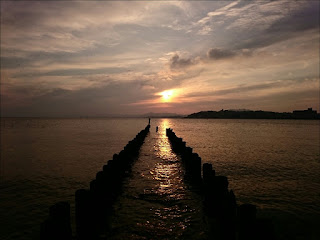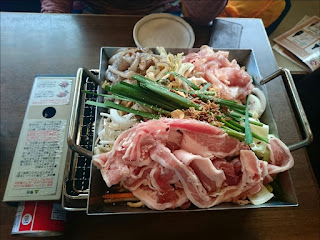Travelling westwards from Tottori and following the coastline, we reached Matsue after a three hour train ride.
The first thing we did in Matsue was to locate the next ATM that supported foreign debit cards because I had completely run out of cash.
My card, however, was rejected - just like in Tottori where I had tried to withdraw money the day before at an identical ATM.
Since I knew there wasn't anything wrong with my card (I had contacted my bank right after the incident in Tottori) and Alessio's wasn't working either, we concluded that the problem lay with the ATM.
We thus sought out the help of the only English speaking employee at the tourist information centre and asked him if there were any other available ATMs.
He promptly suggested to take us to the various ATMs personally, an offer we thankfully accepted. Together we ambled through town, trying each and every ATM - without succes.
My next best chance of withdrawing money would be in the 7/11 store in Hagi, which lay two days ahead of us. Until then I would have to rely on my credit card and Alessio's cash reserves.
Having waisted so much time on looking for an ATM, we were left with only a few things to do in the afternoon.
We decided to explore the old part of town and eventually ended up at an old samurai residence.
It was built in 1730 and inhabited by the Shiomi family, a military family of middle rank.
Everything was laid out very nicely and we got a good idea of how a samurai's household might have looked like.
As it was beginning to rain quite heavily (the rain season had just begun) we got on the tourist bus for a trip around town afterwards.
On the next day we visited Matsue Castle, also known as the "black castle" or "plover castle".
Our rather quirky guide explained us that Matsue Castle was the second largest, the third tallest and the sixth oldest of the only 12 remaining original castles in Japan and the sole remaining in the San-in Region.
Its construction was carried out over a five year period (1607 - 1611) under the rule of Yoshiharu and was designated for warfare, featuring a lookout floor, wooden paneling, arrow and gunholes, stone dropping holes, among other defensive elements.
 |
| the view from the castle's top floor |
Some of the exhibited samurai armors:
There were plenty of other interesting stories and myths surrounding the castle which our guide told us with great enthusiasm and passion. I had trouble following her however, since I was already too occupied with making sure she wouldn't fall and hit her head as she stepped over and bumped into every imaginable object around her.
She later confessed that her clumsiness, coupled with her limited English abilities, were the reasons that she was a free guide.
 |
| a picture of us with our clumsy, yet very likeable and knowledgeable guide |
In the late afternoon we went on a boat trip that took us around Shinji Lake and then watched the sun set over Yomegashima Sanctuary Island with a whole crowd of spectators.
Although the conditions weren't the best, there were plenty of people with expensive-looking cameras and tripods trying to get the perfect shot of the sunset.
I tried my best with my smartphone:
 |
| the Yomegashima Sanctuary Island |
As there was no cloud in the sky the next day, we chose to rent a set of bikes to explore Izumo.
First we cycled to Izumo-taisha, one of the most important and ancient Shinto Shrines in Japan, dedicated to Ookunishi, the deity of marriage and wealth.
The shrine is mentioned in the Kojiki, the oldest chronicle of Japan, but its exact date of establishment remains yet a mistery.
We then carried on to the Inasa-no-hama Beach, which lies about a kilometre from the shrine and is known as "the playground of myths". According to legend, 8 million gods of Japan leave their home shrines once a year and gather on this beach to discuss the Kakuretaru-shinji (secret rituals) for the coming year, such as marriages, deaths and births.
We didn't have much energy left for discussion and thus lay down to tan for a while before hurrying back to town to hand back our bicycles.
We had supper at a local restaurant where no one of the staff spoke a single word of English whatsoever.
As no English menu was provided either, we ordered the only dish of which there was a picture, thinking it was a safe call to make.
But that didn't mean we weren't surprised by what they eventually brought to our table: a platter of raw ingredients which first had to be cooked over a gas stove!
The instructions on how to operate the stove and cook our food were given to us in form of a Google-translated (meaning utter rubbish) note on the waitresses smartphone.
Once again it was time to improvise and we eventually managed to prepare our supper without dying of hunger in the process nor suffering from food poisoning in the aftermath, although we did get laughed at by the other guests quite a lot.





















No comments:
Post a Comment